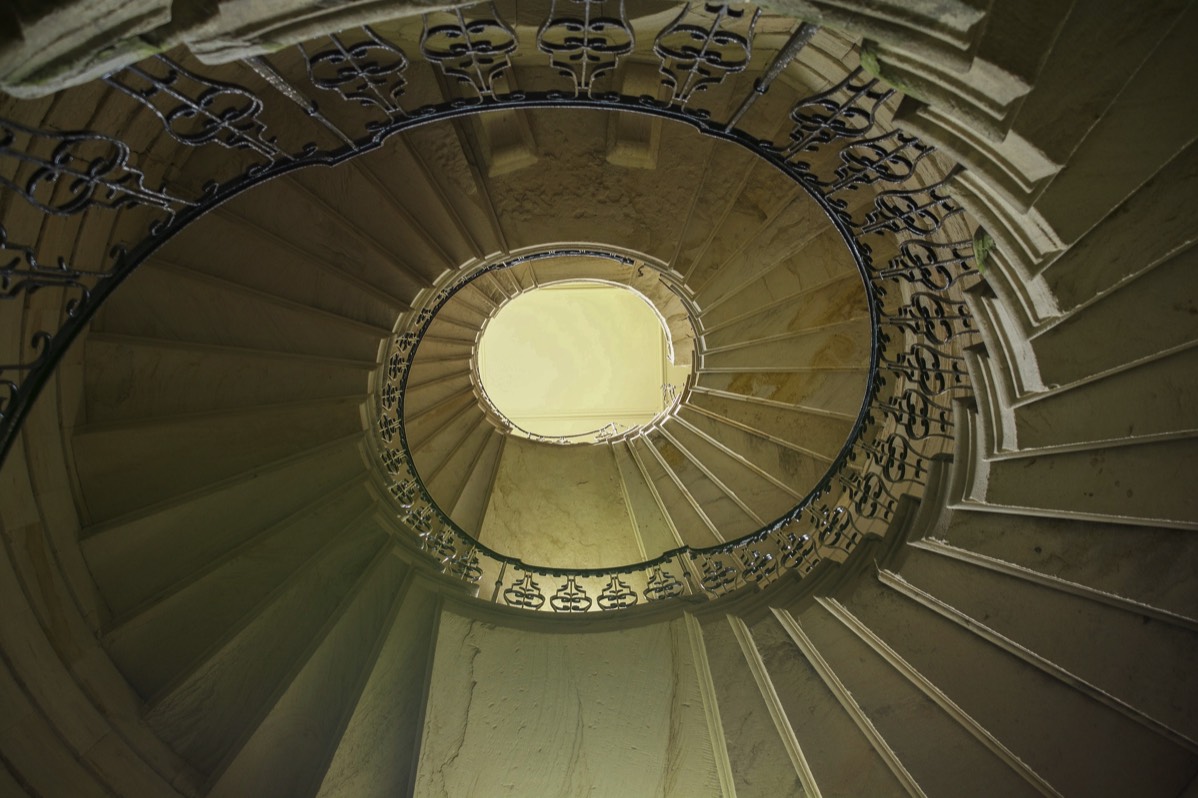Up the Down Staircase

02/7/17 8:35 pm
There’s a book that took the world by storm when it was first published in 1964. Translated into 16 languages, made into a famous movie and staged at many a high school, Bel Kaufman’s Up the Down Staircase tells the story of a young woman who arrives at an inner city high school, ready to transform lives with the power of great literature. Her hopes are quickly dashed by unimpressed students and a frustrating bureaucracy. The administration is concerned only with irrelevant forms and rules, as she soon discovers when a student is admonished for walking “up the down staircase.”
This memorable title captures how life feels, when what we thought was going up goes down instead. And trouble soon follows, as the student found. We resist learning and growing the hard way, but the “university of hard knocks” is usually the best school. Author Richard Rohr describes it as “falling upward.” Falling down can feel like loss, but it’s somehow the very path upward in the life lessons we experience through it.
This title came to mind as our community pondered the Christ hymn in chapter 2 of Philippians, the most commented on passage of the Bible. Most scholars agree that it’s actually a pre-Pauline hymn, reaching back to the very first years of the Church’s existence, one of those songs everyone would have known the words to. Its lyrics are rich in meaning, and many see it as the core of the letter and the heart of Paul’s theology.
The passage describes the poured-out life of Jesus. He had high status with God, but didn’t cling to the advantages that position could have given him. Instead of demanding his rights and going up, he emptied himself and came down to our level. He became the kind of king who aspired only to serve and seek the good of all rather than lording it over others. His path was misunderstood by those who wanted a mighty king and it led to a criminal’s death on a cross, the most disgraceful place of all. Yet mysteriously, it became exactly where God’s glory shone the brightest. Instead of grasping for status in this lowest of places, he allowed his rejection and frustration to drive him toward trust in God’s love.
There’s a basic pattern here which we are invited to follow — self-emptying, status-renouncing and humiliation (vs. 6-8), followed by exaltation and vindication (vs. 9-11). Going up is preceded by going down.
Paul the apostle urges us to model our lives after this “kenotic” (self-emptying) pattern, but if we’re honest, it’s not our natural impulse. We are usually far from other-centered. More often than not, we think about ourselves first, wanting to hold on to any scraps of status we can get. Instead of letting go of our ego and entering into God’s desire for us, we are prone to being self-protective, self-preserving and self-aggrandizing. A voluntary renunciation of our rights in order to serve and obey is a lot tougher than we might think.
Our resistance to this pattern is not unique. Paul wrote that the world sees the way of the cross as folly. It was true then, and true now: humankind does not willingly embrace the “necessary suffering” which leads to growth. Usually the human ego hands over control only when it is forced to; when some insurmountable problem brings us to the end of ourselves. The 12-steppers have discovered this in the first step, “We admit our powerlessness…and that our lives have become unmanageable.” This surrender is the entry to the labyrinth which Joseph Campbell once described as the hero’s path. Jesus walked this path before us and urged that we “take up our cross” like he did. There’s that up the down staircase again.
Cruciformity
During our study, Watershed community learned an unfamiliar but helpful word that captures this pattern: cruciformity. It’s a combination of the words “cruciform” (cross-shaped) and “conformity," and means conformity to Christ crucified. It’s a paradoxical word because the empty cross symbolizes death and life all at the same time. Meet the most puzzling koan of the ages — the One who was put to death is also the One who is alive.
Cruciform is not usually the first descriptor that comes to mind when thinking of the Christian path. We might hope to be spiritual, leading a serene, purposeful life. But “take up your cross”? It’s a bit more unsettling when we realize what Jesus’ life was really like. In Dietrich Bonhoeffer’s famous words, “When Christ calls a person, he bids them come and die.”
It might not sound all that inviting, but it’s exactly this pattern that leads to a meaningful life. As Michael Gorman (author of Cruciformity) writes, “Although it often includes suffering, at its heart cruciformity, like the cross, is about faithfulness and love.” When we answer Christ’s call, our relationships and responsibilities begin to be reshaped by the self-giving, life-giving love of God displayed on the cross. According to Paul, our whole lives are to become cruciform — our thinking, feeling and acting. The cruciform pattern in the Philippians hymn has been described as Paul's master story, the key to unlocking all of Pauline thought.

Paul invited everyone to let this master story permeate their lives. Just as a seed has to first die, it’s about losing oneself as the path to finding oneself. Instead of making ourselves the focus of everything, cruciform love liberates us from ourselves. It is exercised for others, not over others. The cross may look foolish to the world, but it ends in glory not shame as God-in-Christ transcended the worst of what humankind did to him.
This, said Paul, was what the Philippians should model their lives after. To go up, we need to go down. Give up our ego, care about others more than we care about ourselves, extend ourselves and participate fully in the human experience. Jesus said if we want to become something greater, first we have to descend and leave the vindication up to God. Love, not might and dominance, defines what power is all about.
The Downward Movement of Love: An Example
In our community, the cruciform pattern became a koan we pondered throughout the study. It’s easy to think of heroes such as Nelson Mandela who chose to forgive unjust imprisonment or Winnipeg’s Wilma Derksen who chose to forgive her daughter’s murderer. Their paths “up” first had to go down through cross-like suffering. But I wondered, how did cruciformity translate in my own mundane life?
I knew all about glory once, a teacher with a decent salary, a title and the worship of at least some of my 8 and 9 year old students.
I might have had outward success, but inwardly my life was in shambles. The question Jesus once asked his disciples was beginning to apply to me, “What does it profit a person to gain the whole world but lose their soul?” It was becoming harder and harder to be myself and I was not happy. My co-workers knew about my headaches, but I hid the deeper struggles from them. I prayed for a way forward, and one day an honest administrator told me, “Something has happened to you. You’re not the same. You need a break.”
I’m sure she had no idea she was an answer to prayer. I took a leap of faith, listening to feedback from my faith community, and left the job I’d struggled to succeed at for so long. God guided in many ways, and the temporary leave led to a decision to retire. A new vocation of writing opened up and I was grateful for a chance at a new life.
But underneath, I couldn’t shake a feeling of failure. Hadn’t I let my students down? Was it right to leave? A certain nostalgia about the old life kept on gripping me. I should have been feeling the joy of resurrection, but instead I was stuck in the humiliation of failure. The downward movement of cruciformity is supposed to lead to resurrection, but I had to admit I still wasn’t fully celebrating.

I had to take another step down and look more closely at what led to my leaving. The surface reason had been headaches, but deeper down something had distorted my relationship to the students. If I was honest, what wore me down in the end was a lifelong pattern of emotional catastrophizing and people pleasing which made me work way harder than I needed to. Instead of resting in my identity as God’s loved daughter, I thought I had to earn acceptance myself. This led to burn out.
We can’t really know what Jesus experienced on the cross, perhaps disappointed and certainly abandoned during what looked to the world like a scandalous failure. I just felt embarrassed and ashamed, but in his valley, he turned to his Father in trust for a way forward. It was this story that gave me a pattern to live by. If God could use this most shameful of places (“even death on a cross”) as the exact place resurrection happens, then surely God could use my failure for His purposes.
God welcomes those places we consider shameful. I turned to God and gave him my humiliation and sense of failure, leaning into the hope that death is not the end of the story. In our failures, God doesn’t say, “What’s wrong with you?” but, “I’ve been there; I’m here now. I’ll walk with you.”
I can’t say I’m completely through this time, but God keeps showing up amid my bumbling ways, giving rest and faithfully showing the way to an expansive life. I’m going to keep banking on the pattern expressed in that ancient hymn.
Maybe, just maybe, God can transform all our failures into something beautiful. Lord knows we all need a new song to sing.
Let the same mind be in you that was in Christ Jesus, who, though he was in the form of God, did not regard equality with God as something to be exploited, but emptied himself, taking the form of a slave, being born in human likeness. And being found in human form, he humbled himself and became obedient to the point of death—even death on a cross. Therefore, God also highly exalted him and gave him the name that is above every name, so that at the name of Jesus every knee should bend, in heaven and on earth and under the earth, and every tongue confess that Jesus Christ is Lord, to the glory of God the Father (Philippians 2:5-11 NRSV).
Resources
Cruciformity: Paul’s Narrative Spirituality of the Cross by Michael J. Gorman — Watershed is eternally indebted to Gorman for unpacking the word “cruciformity” in this excellent book.
Falling Upward: A Spirituality for the Two Halves of Life by Richard Rohr — Rohr writes that we often confuse the 1st half of life tasks of order and control with the spiritual journey, where it’s all about letting go and entering the necessary suffering that leads to finding the meaning of your own life.
Listen to Richard Rohr speak about Falling Upward in these two excellent, short videos.
https://www.youtube.com/watch?v=4og_LyEsiN0
https://vimeo.com/161984922
The Way of Letting Go: One Woman’s Walk Toward Forgiveness by Wilma Derksen
Wilma Derksen is a Winnipeg woman who has chosen the cruciform path of forgiveness after her daughter was murdered in 1984. Read a short description and hear an interview here.
Read this article by Watershed’s pastor/teacher Paul Patterson, who describes when falling “up the down staircase” at age 4 held rich lessons through his life.
Question of the Week
Describe an example of when the way down led to the way up; when God transformed failure or fallenness into something new.